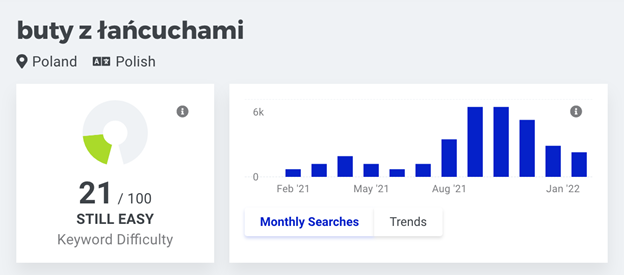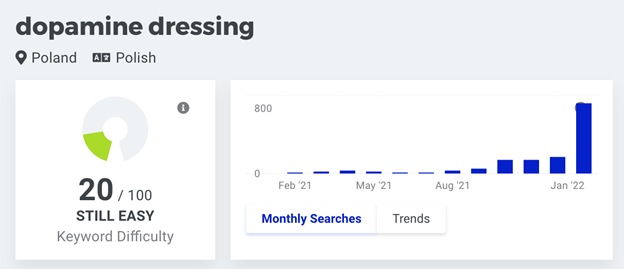Trend life cycle vs. SEO efficiency: How can you make e-commerce ready for the incoming sales?

Contents
Introduction
A new product launch, especially such with high sales expectations both in the offline channel as well as on the Internet, should always be preceded by a thorough analysis of the customers’ needs and opportunities to reach them. Once we know what a prospective customer is looking for, we can lead them to a product through advertising or guide content.
As the product visibility increases, so does interest in it, followed by sales. The growth dynamics depends to a great extent on the intensity of the activities performed.
The process is somewhat different for fashion products, as it is driven by fashion trends inspired by world designers. Once a product is presented at a fashion show or during Fashion Weeks, it generates interest. The trend is soon picked up by large brands leading the market, followed by the smaller ones, oftentimes held by celebrities and bloggers, who are keen to capitalize on and showcase the new trend before their competitors do. Based on the “fashion phrases” examples, let’s take a look at how such a trend develops and then suggest how to properly plan online activities, which will help achieve top search results at the peak of trend’s popularity.
Here are a few examples from the fashion industry that perfectly demonstrate a new trend’s life cycle.
Trend: “square-toe shoes”

There was already a visible interest in this type of footwear at the end of 2018, when the first trends came to light at the Fashion Weeks events, especially in Bottega Veneta’s label collections. Since then, it has grown steadily, reaching its first popularity peak in late 2018. Nowadays, this trend is attracting ever-growing interest.
Trend: “chain shoes”

This trend strongly prevailed at the fashion shows featuring the Spring/Summer 2021 collections, which translated directly into the number of searches for this type of footwear. Models with chain detail featured, for example, in Versace’s collection at Milan Fashion Week in late 2020. Apparel brands have successfully adopted this trend, increasing the popularity of chained sandals and moccasins, followed by chained ankle booties and boots in the autumn season.
Trend: “dopamine dressing”

Dopamine dressing is an exciting example of a trend’s life cycle, having taken over the shows at Copenhagen Fashion Week in August 2021. From that point on, the trend known as happy hormone-boosting fashion has seen a gradual rise in interest. As the New Year dawned, virtually all fashion websites accentuated this trend heavily, which translated into a significant increase in take-up. Thus, using this concept to promote fashion ranges online can have a significant impact on sales.
One of the greatest challenges facing today’s e-commerce business is figuring out an effective way to gain a competitive advantage. The more competitive the market in which we operate and the more the product has to compete for customers’ attention, the more difficult this task becomes. In terms of position building in the free search results, it means that we need to target our efforts based on our website’s visibility on key phrases with a high number of searches, and compete for a top 10 rank. The battle is waged not only against our direct business competitors, but also other sites, blogs or platforms offering video content. Being newcomers to the market, it can be a difficult and time-consuming task to keep up with the competition. Imagine, however, that our product is a complete novelty. We have just come back from Fashion Week and we discovered a trend there, based on which we want to launch a new product. Provided we succeed in manufacturing a product range relatively quickly, at the same time we can prepare for the growing interest in the novelty and thus render it more difficult for competitors who start later.
Let’s start with the content. Because we can create and publish it on our website whether or not we already hold a product ready for sale.
Phase 1: Developing information content
During the first life-cycle stage of the new fashion trend, consumers’ interest will still be low and potential audience will first look for basic information: “how to wear…”, “what to combine with…”, “how to create a look with…”, “celebrities + <trend>.” So let’s make our website the first and maybe even the only search result. To this end, we can develop a dedicated landing page or sub-page within our e-store. Fashion groups in social media or online forums, where users engage in discussions about the trend, can serve as inspiration for valuable content from the perspective of those interested.
Make sure that the content includes key phrases related to the trend and various trend descriptions, even though at this stage they will not have the search potential. They should appear:
- in the body of paragraphs,
- in the title and headings,
- in the alt attributes of images,
- in the title and description metadata section, which is displayed in search results.
Doing this quickly will give us the opportunity to become a reliable source of information. Importantly, our content will be distributed naturally, which can give us additional benefits in the form of high-value links.
Phase 2: Content update
Keep in mind that as the trend evolves, an increasing number of related issues will arise. Thus, it is very important to update our content regularly with new information. Aside from using phrases closely related to a given trend, at this stage it is also worth extending the content with:
- key phrases as questions – the relevant ones are most likely to be found in user discussions on internet forums or social media groups,
- complementing queries in the Google search engine that is using the Autocomplete feature: once a given phrase is entered into the browser, its extensions based on queries of other web users will be prompted.
Phase 3: Product announcement and increased likelihood of conversion
Information and guidance content alone, however, will not be sufficient to ensure that the user will be returning to our website once the product is available. Thus, let’s make sure that we maintain their interest or, to put it bluntly, make them loyal and bring them closer to purchase by sustaining their interest. To this end, we should enrich the content with the following elements:
- newsletter subscription box – once we have added a user’s email address to our database, they will be able to receive our regular updates relating to the category of product we intend to develop and in which they have been initially interested,
- ‘waiting list’ sign-up box – which informs the user directly about the upcoming product release date and its availability.
With the perfectly developed content published on the website, we can start analyzing its effectiveness. To this end, we will need to set up a suitable analytical tool, such as the popular Google Analytics, which will allow us to monitor the following metrics:
- the number of sessions and users, which will tell us how large an audience our content reaches and how this number changes over time,
- the Bounce Rate, which reflects the percentage of the website visits that end in visitors leaving the site without exploring it further,
- the average time spent on the website informs us whether the content is appealing to the user.
You may also benefit from configuring the tool to track events such as:
- page scrolling,
- hovering over a given element (e.g. a graphic),
- downloading a file (e.g. a graphics or pdf document),
- video viewing.
With all of these, we can gain knowledge about user behavior on our website. We will then be able to modify the communication accordingly to make it as relevant to the audience as possible.
As the trend popularity grows, so will the competition in search results. This will include not only sites providing fashion or lifestyle content, but also other e-commerce sites that have managed to launch a new product faster. Measures to help you gain a competitive advantage include:
- Working with fashion / trendsetting websites to publish guest articles featuring our brand linked to a particular product.
- Working with bloggers / vloggers who will present and promote our product, produce a review or share with their followers discount codes for its purchase.
- Publishing sponsored articles with links to our website.
Putting these measures in place will definitely have a positive effect. The brand or specific product information will be spread beyond our website. In addition, we obtain high value external links to our website, which will help us maintain high search results ranks for phrases related to our content, and later on – to the product.
All of the above measures are aimed at establishing our reputation in a given field and strengthen the website’s search results ranking for phrases closely related to a particular trend. At the height of the trend, users start to explore the internet more intensively, looking for reliable information on a given topic. At this stage, there will certainly be many other online sources besides our content. This is a time for us to keep a close eye on what our competitors are doing, so that we are able to act in good time on any sign that we may be losing ground to them.
What will help us to analyze?
- We track search results regularly (at least once a week) and monitor what sources come up for our key phrases.
- We research topics for articles that can be linked to a particular trend.
- We analyze user behavior on the website.
- We analyze the competitive websites’ content and continuously expand our content with issues that are missing and related to the trend.
Every single industry has its own specifics and a specific product life cycle. It is important, however, to be well prepared in advance for trends that are yet to come, to be able to spot them and effectively convert to your advantage before they become obvious and widespread. This approach provides an opportunity to become an expert and leader in your industry, stay ahead of the competition and be the first to start selling.
Some of the examples we have pointed out are illustrative of the fashion trend life cycle, showing the dynamics at which interest in a particular concept grows over time. Being aware of the underlying mechanics of trends and knowing how to map them out over time will allow you to be prepared in advance to launch a product that is not yet popular, so that when it is at its peak, you can achieve high ranks in search results, bringing converting traffic to your website. In the fashion industry, but also in any other segment, e-commerce requires not only flexibility and dynamic creativity. It also calls for a long-term, forward-looking view of the business landscape as well as detailed and informed analytics to help build brands and boost sales. Do not forget that sales happening here and now starts often many months before with a good decision and informed, responsible planning.